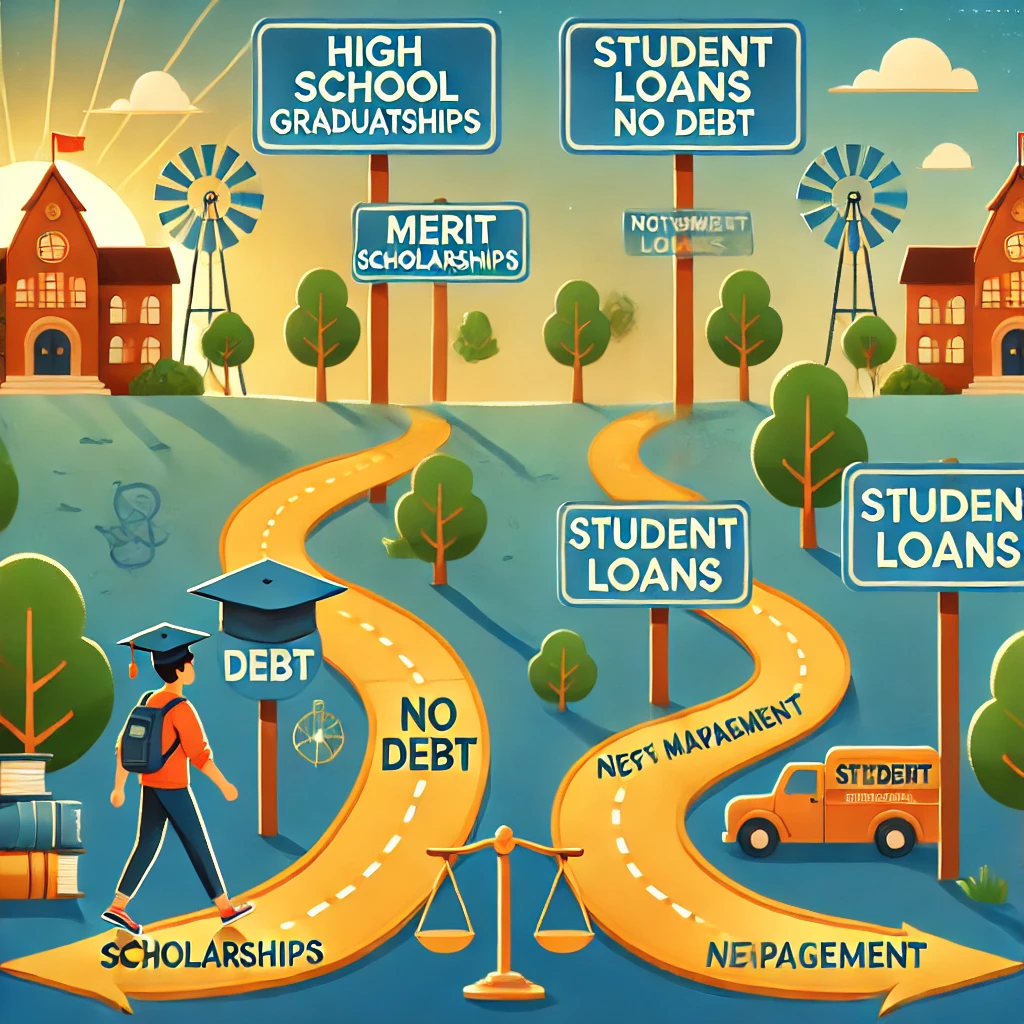Choosing how to fund your education is one of the most critical financial decisions you'll make as a student. With tuition fees, accommodation, books, and living expenses rising globally, deciding between scholarships and student loans can feel overwhelming. Each option has its own set of advantages, drawbacks, and long-term consequences.
This comprehensive guide breaks down everything you need to know about scholarships and student loans—from definitions and comparisons to real-life examples, expert advice, and frequently asked questions—to help you make an informed decision.
📘 What Are Scholarships?

A scholarship is a monetary award granted to students to help cover educational expenses. Unlike loans, scholarships do not need to be repaid, making them an ideal form of financial aid. They are awarded based on criteria such as academic merit, financial need, talents, demographics, and more.
🎓 How Scholarships Work
-
Eligibility: Varies by program; may be based on academic achievement, financial status, field of study, background, or region.
-
Coverage: Can include tuition, living costs, books, transportation, and sometimes stipends.
-
Application Requirements: Often include essays, recommendation letters, transcripts, proof of need or merit, and interviews.
📚 Common Types of Scholarships
| Scholarship Type | Description |
|---|---|
| Merit-Based Scholarships | Based on academic excellence or special talent. |
| Need-Based Scholarships | Targeted toward students from low-income families. |
| Athletic Scholarships | For students with exceptional sports performance. |
| Subject-Specific Scholarships | For those studying fields like STEM, arts, or humanities. |
| Demographic Scholarships | Based on ethnicity, gender, religion, or region. |
| Government Scholarships | Sponsored by national or local governments (e.g., Chevening, Fulbright). |
| Private/Corporate Scholarships | Offered by companies, NGOs, and foundations. |
🌟 Benefits of Scholarships
-
No repayment required
-
Reduces or eliminates student debt
-
Encourages academic excellence
-
Often includes access to networks, internships, or mentorship
-
Enhances resume and career opportunities
🌍 Popular Scholarship Programs in 2025
-
Chevening Scholarships (UK)
-
Fulbright Program (USA)
-
DAAD Scholarships (Germany)
-
Erasmus Mundus (European Union)
-
Vanier Canada Graduate Scholarships (Canada)
💸 What Are Student Loans?
A student loan is a form of borrowed money that you must repay with interest. Student loans can come from governments, banks, or private lenders and are used to cover tuition, accommodation, books, and living expenses.
🏦 How Student Loans Work
-
Repayment: Begins after graduation, usually following a grace period (varies by country).
-
Interest: Accrues either during studies or after graduation.
-
Repayment Assistance: May include income-based repayment plans, deferments, or loan forgiveness (depending on loan type).
🔍 Types of Student Loans
1. Government Loans
-
Offered by national or regional governments
-
Lower interest rates and flexible repayment
-
Examples:
-
U.S. Federal Loans (FAFSA: Stafford, Perkins, PLUS)
-
UK Student Finance England
-
Canadian NSLSC or OSAP
-
2. Private Loans
-
Offered by banks, credit unions, or fintech lenders
-
Higher interest rates, stricter eligibility
-
Often requires a credit check or co-signer
✅ Benefits of Student Loans
-
Broad accessibility
-
Can fully cover tuition and living expenses
-
Helps build credit history
-
May offer flexible repayment terms
🧾 Scholarships vs. Student Loans: Comparison Table

| Criteria | Scholarships | Student Loans |
|---|---|---|
| Repayment | Not required | Required, with interest |
| Award Criteria | Merit, need, demographics | Credit score, financial need |
| Application Process | Competitive (essays, recommendations) | Often straightforward |
| Financial Risk | None | Medium to high |
| Availability | Limited; highly selective | Widely available |
| Long-Term Impact | No debt; financial freedom | Potential long-term debt burden |
| Maintenance | May require GPA maintenance | Repayment starts post-graduation |
| Funding Type | Gift aid (free money) | Borrowed aid (with interest) |
📅 When Should You Choose a Scholarship?
You should apply for scholarships if you:
-
Have strong academic or extracurricular achievements
-
Come from a financially disadvantaged background
-
Wish to graduate debt-free
-
Can dedicate time and effort to application processes
-
Meet the eligibility requirements of available scholarships
Tip: Start searching early and apply to multiple scholarships to increase your chances.
💳 When Should You Consider Student Loans?
Student loans are appropriate when:
-
You were not awarded sufficient scholarships
-
You are enrolled in high-cost programs (medicine, law, aviation)
-
Your chosen field or region offers limited scholarships
-
You understand the loan terms and have a repayment plan
-
You have high earning potential post-graduation
🔍 Real-Life Scenarios
Scenario 1: International Student in the U.S.
Problem: Tuition = $30,000/year; scholarship awarded = $15,000
Solution: Use a combination of student loan and part-time job to cover the rest.
Scenario 2: Low-Income Student in Nigeria
Opportunity: Fully funded international scholarship available
Solution: Accept the scholarship. No debt and full coverage = ideal scenario.
Scenario 3: Student in the UK Without a Scholarship
Option: Eligible for Student Finance England
Solution: Take the government loan and repay based on income after graduation.
💡 Tips for Getting Approved for Student Loans
-
Build Good Credit (or Use a Co-signer)
-
Maintain a score above 650
-
Use secured credit cards or become an authorized user
-
Federal loans often don’t require credit history
-
-
Only Borrow What You Need
-
Calculate actual expenses
-
Avoid borrowing for “extras” or luxuries
-
-
Understand Loan Terms Clearly
-
Know the interest rate (fixed or variable)
-
Check grace periods and repayment start dates
-
-
Compare Multiple Lenders
-
Use comparison tools like Credible, NerdWallet
-
Look at repayment options, penalties, and reviews
-
-
Ask the Right Questions
-
Can I pause payments if I lose my job?
-
Is early repayment penalized?
-
What happens if I default?
-
-
Apply Early
-
Many loans and scholarships are awarded on a first-come, first-served basis
-
🧠 Tips for Managing Student Loans Responsibly
-
Understand Terms: Know the rate, repayment plan, and due dates
-
Borrow Smart: Never take more than you need
-
Choose Government Loans First: They often offer better terms
-
Track Spending: Budget wisely
-
Plan Early for Repayment: Consider income-driven plans post-graduation
🔄 Can You Combine Scholarships and Student Loans?
Yes—and it's often the smartest approach.
Example Funding Mix:
-
40% from scholarships
-
10% from grants or savings
-
50% from student loans
This strategy minimizes debt while ensuring your costs are fully covered.
🌐 Special Considerations for International Students
-
Look into country-specific scholarships (e.g., CSC in China, MEXT in Japan, Australia Awards)
-
Consider international loan providers like MPower, Prodigy Finance, and Fly Finance
-
Ensure the school is recognized by both host and home country
-
Be mindful of currency exchange rates when repaying loans
📊 Long-Term Financial Impact: Scholarships vs Student Loans
🟢 Scholarships
-
No debt = faster financial independence
-
Freedom to choose jobs based on passion, not salary
-
Build wealth sooner through saving and investing
-
Better credit profile due to fewer obligations
🔴 Student Loans
-
Debt stress: Monthly payments reduce disposable income
-
Delayed milestones: Homeownership, marriage, and travel may be postponed
-
Restricted job choices: May have to prioritize high-income roles
-
Compounded interest: Especially dangerous with private loans
🟡 Combining Both
-
Balanced approach
-
Smaller loan amounts = easier, faster repayment
-
Preserves credit score
-
Gives access to top-tier education
🧭 Final Verdict: Scholarships or Student Loans?
| Choose Scholarships If | Choose Student Loans If |
|---|---|
| You meet merit or need-based eligibility | You can’t secure enough scholarships |
| You want to avoid debt | You're in a high-cost program like medicine or aviation |
| You are diligent in applying and maintaining requirements | You have high earning potential post-graduation |
| You prefer financial independence after school | You have access to subsidized or income-based repayment plans |
✅ Conclusion: Make the Smart Choice for Your Future
Your education is an investment—but it doesn't have to leave you in financial ruin. Start with scholarships whenever possible. They're free, empowering, and debt-free. If needed, supplement with responsible borrowing through government or private student loans.
By being informed, proactive, and strategic, you can achieve your educational goals without compromising your financial future.
📌 Remember: The best financial decision is an informed one. Research your options, apply early, and plan ahead. Your future self will thank you.
![Scholarships vs. Student Loans: Which Should You Go For? [Complete Guide for 2025]](https://uknia.com/uploads/2025/05/1747143951-scholarships-vs-student-loans-which-should-you-go-for-complete-guide-for-2-20250513-143533-0000-1024x615.png)
You must be logged in to post a comment.